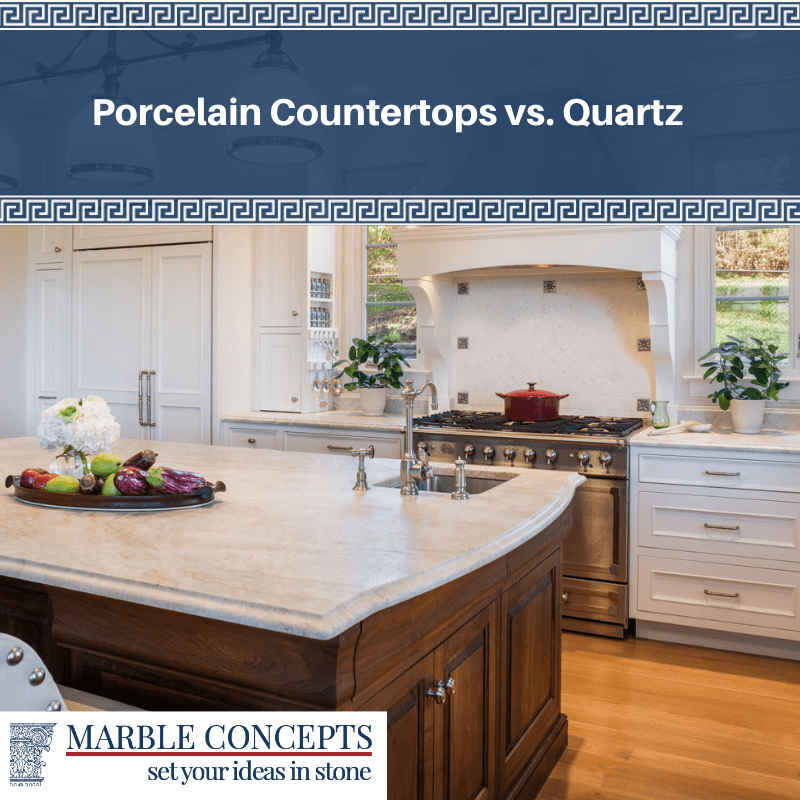With so many options available, Marble Concepts understands how difficult it is to decide which countertop is perfect for your family. You can choose from granite, marble, quartz, tile and so many more today that narrowing down the right choice can be extremely frustrating. Because we are one of the best granite companies nearby, we want you to make an informed choice. Quartz is one of the most popular options in countertops, but you may want to look into whether porcelain would be a better choice.
What is Porcelain?
Porcelain is created using vitrified pottery material which may be translucent but is usually opaque. Powdered china stone is mixed with a white clay called kaolin then heated at extremely high temperatures. The china stone becomes solid while the kaolin retains the shape. After it is baked, a pigmented glaze is added as a coating to create a wide range of patterns and colors.
What is Quartz?
Quartz countertops are created by mixing crushed quartz, one of the hardest stones on Earth, with polymers and pigments to create a durable, non-porous substance. Because most countertops contain as much as 90 percent quartz, they are considered natural stone countertops.
Maintenance and Durability
Natural stones require sealants periodically to prevent stains, bacteria, and other substances from spreading beneath the surface. You also may need to use special cleaners on natural stone surfaces in order to prevent scratches or dulling of the stone. Both quartz and porcelain are engineered which means they do not need periodic sealing and chemicals do not damage the surface. Although both resist stains, porcelain is also safe to use in outdoor kitchens as it resists UV rays while quartz may fade in direct sunlight. Quartz resists cracking and chipping than porcelain, although both are rather difficult to damage. Porcelain is known to scratch if you use ceramic knives directly on the surface, however.
Depth of Appearance
It is possible that someone who works for granite companies nearby might notice a difference between quartz and porcelain. They do feel different when you touch them, so an experienced professional may be able to recognize either quartz or porcelain. To the average person, however, both stones give the appearance of natural stone. The way they are manufactured may create a few differences, however. Because porcelain only has a pattern on the surface, it may not have quite as much depth as quartz counters. If you chip your porcelain counter, you will notice that the veining and color do not extend below the surface, while a chip on a quarter counter will reveal the same pattern and color beneath the surface.
Thickness and Slab Size
Both porcelain and quartz are available in slabs that are much larger than other natural stones, according to Marble Concepts. If you have a very large kitchen, porcelain and granite may be a better option as larger slabs mean fewer seams. One area where porcelain differs from quartz, however, is in thickness. It is often thinner which may limit the finishing details you may choose. Mitered edges are used to create a thicker look, but that is usually the only variation at the present time. Because porcelain is thinner and lighter, however, you may not need to reinforce your cabinetry in order to install the countertops.
Environmentally Friendly
Both quartz and porcelain are environmentally friendly as they can be recycled. This can help you reduce your impact on the environment when it comes time to remodel your kitchen again. Both porcelain and quartz are considered green surfaces which means you may recycle them when it is time to replace them.
Heat Resistance
When it comes to heat resistance, porcelain has an edge over quartz. Because quartz counters contain resins, it is not recommended that you place hot pans from the stove directly on the counter surface. Porcelain, because it is baked at high temperatures and contains no resins, has a much better heat resistance than quartz. You can place hot pans taken from the stove directly on the counter without damaging the surface of a porcelain countertop.
Wide Range of Colors and Design
Both quartz and porcelain countertops are available in a wide range of colors and designs. You can find countertops in both that mimic the look of granite and marble, both popular natural stone countertop options. However, because the design and color in a porcelain countertop are added after the countertop is created, you can actually find more options in porcelain. It is possible to find countertops that mimic the look for woodgrain, burnished steel, cement, and even linen that are actually porcelain. In addition, porcelain is also available as tile which gives you even more options when it comes to creating a specific look in your kitchen. Both quartz and porcelain provide a uniform look since each slab is the same, unlike granite or marble.
Costs of Each
Porcelain is usually slightly more expensive than quartz due to the more difficult fabricating process. It is also just becoming popular which may make it difficult to find at many granite companies nearby. Porcelain is easily cracked or chipped during the fabrication and installation process, although it is extremely durable once it is installed. This also can add to the expense of porcelain over quartz.
When you are considering a kitchen or bath remodel, contact Marble Concepts to learn more about your countertop options. We have more than 50 years’ experience with all types of stone, including porcelain and quartz. We will guide you through the process and help you choose the countertop that is perfect for your family’s needs. We live by our motto to “set your ideas in stone.” Contact us today by filling out the easy online form or give us a call to learn how we can help you create the kitchen and bathroom of your dreams. We complete every job as if it were for family because we believe all of our customers are part of our family.






